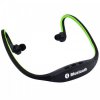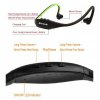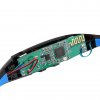Hello all from Australia. This my first post. I can solder and do basic repairs to electrical stuff but I'm no electronics whizz so I'm hoping you can offer some advice for an idea I have. I want to convert a bluetooth headphone to a hearing aid.
A little background might help. My 93 year old mother has a couple of expensive hearing aids that work nicely 'when they work' and when she has them 'installed'. But the trouble is, at her age, fitting them can be a hassle, they can cause pain and infection when worn constantly (because 'old skin' is very delicate), and they are fiddly to adjust. So it occurred to me that if she had a simple headphone style hearing aid that she could easily take on and off as required it would give her ears a break from having to wear the real hearing aids all day long.
A search on ebay found the following headphones that appear to have all the basics for the hearing assistance gizmo that I have in mind. They have built in microphones and speakers, a volume control, and are rechargeable with a USB cable. They are only $12 a pair so I have 2 pairs on the way to play with. Normally of course these would be used for hands free phone communication but I want to convert them into a very simple 'all in one' hearing aid that even a 93 year old with failing comprehension can operate.
My idea is to somehow route the incoming sound (e.g. my voice) directly from the built-in microphones to the earpiece speakers. I'm wondering if this can be done, either by simple hard wiring, or by some wireless method that transmits the microphone pick up instantly back to the earpieces.
I hope thats all explained well enough to get your interest. When the headphones have arrived I'll open them up for some photos if that would be helpful.
In the meantime have a think about it. I don't know if it can be done, maybe I'm dreaming, but I look forward to your thoughts anyway.
Cheers.
\

A little background might help. My 93 year old mother has a couple of expensive hearing aids that work nicely 'when they work' and when she has them 'installed'. But the trouble is, at her age, fitting them can be a hassle, they can cause pain and infection when worn constantly (because 'old skin' is very delicate), and they are fiddly to adjust. So it occurred to me that if she had a simple headphone style hearing aid that she could easily take on and off as required it would give her ears a break from having to wear the real hearing aids all day long.
A search on ebay found the following headphones that appear to have all the basics for the hearing assistance gizmo that I have in mind. They have built in microphones and speakers, a volume control, and are rechargeable with a USB cable. They are only $12 a pair so I have 2 pairs on the way to play with. Normally of course these would be used for hands free phone communication but I want to convert them into a very simple 'all in one' hearing aid that even a 93 year old with failing comprehension can operate.
My idea is to somehow route the incoming sound (e.g. my voice) directly from the built-in microphones to the earpiece speakers. I'm wondering if this can be done, either by simple hard wiring, or by some wireless method that transmits the microphone pick up instantly back to the earpieces.
I hope thats all explained well enough to get your interest. When the headphones have arrived I'll open them up for some photos if that would be helpful.
In the meantime have a think about it. I don't know if it can be done, maybe I'm dreaming, but I look forward to your thoughts anyway.
Cheers.
\


Last edited:

